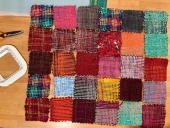Industrially grown cotton has a lot of chemicals involved in growing and processing. These dyes and other stuff, could get in the air and cause problems. So I'm looking at alternatives to regular weaving cotton. Once I use up my existing stash, I hope I can start working only with organic materials.
This is exactly why I switched (in the early nineties) to organic or no pesticide warps and wefts (Romanian hemp and foxfiber color grown cottons and some unbleached
linen) and well used/washed recycled clothes for 'rag' wefts after a decade of weaving with what ever I felt inclined to use, mostly natural fibers commercially dyed.
Just browsing some of the conventional farming magazines ads for cotton farming inputs was enough to convince me along with knowing some of the commercial dye processes and then assuming that some at least of those chemicals are carried through the dust into my lungs.
At the same time, I was working on integrating my work for money with our lifestyle, so organic and recycled fit perfectly.
Health issues aside, it was an important step for me to see that I needed to use the same standards for my money earning work as we tried to use for our homestead....lots of choices became clearer and I then had the job of explaining that to my customers.
I did not solve the dust/lint issue even after more than thirty years, and of course, dust is dust, even organic dust and lint can cause lung problems.
For the first ten years that I wove we had no utilities, public or otherwise, so no fan, etc.
Later I sometimes used a fan blowing across the warp.
An air filter is a smart move.
I've sprayed water on some terribly fuzzy linen warps but never tried with cotton.
Does Canada have reasonably priced hemp now?
Ecolution from Romania had natural and peroxide bleached in many weights. The yarn had come along way from the early rough twine and was wonderful to weave with and had little fall out.
Foxfiber color grown organic cotton was beautiful and a wonderful warp but lots of lint while weaving.
Both of these company's also had the problem of a shipping footprint
I'm not sure any of this is really helpful, I'm thinking in fragments at the moment, kind of rambling a bit......
You do such wonderful work and I can see you're in this for the long haul....worth putting the thought and effort into making it as safe and healthy as possible.
















 3
3




 1
1




 3
3




 1
1






































